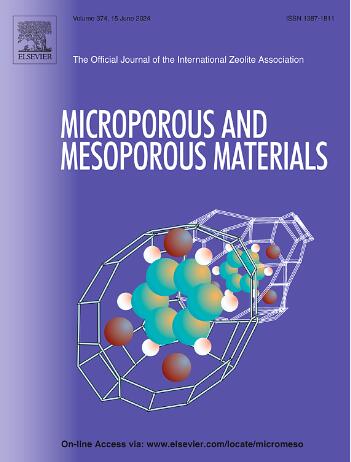Catalytic hydrocracking of 9,10-dihydroanthracene on HY zeolite – Activity dependence on acid strength
IF 4.8
3区 材料科学
Q1 CHEMISTRY, APPLIED
引用次数: 0
Abstract
Due to the practical importance of Y zeolites in catalytic hydrocracking of polyaromatic hydrocarbons, the detailed mechanisms of 9,10-dihydroanthracene catalytic hydrocracking on HY zeolite with different Al substitution (1Al, 3Al, 6Al; Si/Al = 47, 15, 7) and 6Al with trinuclear extra-framework Al (EFAl) in the sodalite cage (6Al + EFAl, Si/Al = 4.67) in different acid number and strength have been computed. It is found that the heterolytic activation of H2 encapsulated within a conjugated Frustrated Lewis Pair (FLP), generated by the transfer of acidic O-H proton to hydrocarbon substrate, is the rate-determining step for the formation of 1-benzyl-2-methylbenzene and its conversion to benzene, toluene, and o-xylene. A correlation between Brønsted acid strength (enthalpy of adsorption of pyridine) and catalytic activity (apparent Gibbs free energy barrier) has been found, e.g., a higher acid strength corresponds to a lower apparent Gibbs free energy barrier and therefore higher catalytic activity. Since the conversion of 1-benzyl-2-methylbenzene has lower apparent Gibbs free energy barrier than its formation, its detection under the reaction condition is difficult or unlikely.

求助全文
约1分钟内获得全文
求助全文
来源期刊

Microporous and Mesoporous Materials
化学-材料科学:综合
CiteScore
10.70
自引率
5.80%
发文量
649
审稿时长
26 days
期刊介绍:
Microporous and Mesoporous Materials covers novel and significant aspects of porous solids classified as either microporous (pore size up to 2 nm) or mesoporous (pore size 2 to 50 nm). The porosity should have a specific impact on the material properties or application. Typical examples are zeolites and zeolite-like materials, pillared materials, clathrasils and clathrates, carbon molecular sieves, ordered mesoporous materials, organic/inorganic porous hybrid materials, or porous metal oxides. Both natural and synthetic porous materials are within the scope of the journal.
Topics which are particularly of interest include:
All aspects of natural microporous and mesoporous solids
The synthesis of crystalline or amorphous porous materials
The physico-chemical characterization of microporous and mesoporous solids, especially spectroscopic and microscopic
The modification of microporous and mesoporous solids, for example by ion exchange or solid-state reactions
All topics related to diffusion of mobile species in the pores of microporous and mesoporous materials
Adsorption (and other separation techniques) using microporous or mesoporous adsorbents
Catalysis by microporous and mesoporous materials
Host/guest interactions
Theoretical chemistry and modelling of host/guest interactions
All topics related to the application of microporous and mesoporous materials in industrial catalysis, separation technology, environmental protection, electrochemistry, membranes, sensors, optical devices, etc.
 求助内容:
求助内容: 应助结果提醒方式:
应助结果提醒方式:


